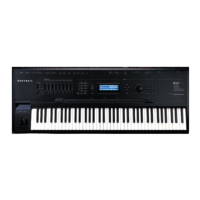Editing Conventions
Introduction to Editing
5-1
Chapter 5
Editing Conventions
Introduction to Editing
Programming (editing) the PC3 always involves three basic operations: mode selection,
navigation, and data entry.
First, select the mode that relates to the object you want to edit—a program, a setup, etc. Then
select the object you want to edit, and press the Edit button to enter the editor within that mode.
An editor contains all the parameters that define the object you’re programming.
Next, you navigate around the editor’s page(s) with the soft buttons, and select parameters with
the cursor (arrow) buttons. When you’ve selected a parameter (its value is highlighted by the
cursor), you can change its value with one of the data entry methods. When you change a value,
you’ll normally hear its effect on the object you’re editing. The PC3 doesn’t actually write your
editing changes to memory until you save the object you’re working on. It then allows you to
choose between writing over the original object, or storing the newly edited version in a new
memory location.
What’s an Object?
If you’ve been wondering what we mean by the term “object,” it’s an expression we use for
anything that can be named, saved, deleted, or edited. Here’s a list of all the types of objects:
Programs Factory-preset or user-programmed sounds stored in ROM or flash
memory. A program is one or more layers of sound, with programmable
DSP functions applied to the keymaps within each layer.
Setups Factory-preset or user-programmed MIDI performance presets consisting
of up to 16 zones, each with its own program, MIDI channel, and
controller assignments, and (optionally) arpeggiation specifications.
Songs Sequence files loaded into memory, or MIDI data recorded in Song mode.
Chains Factory-preset or user-programmed configurations of the PC3’s onboard
digital audio effects processor.
Quick Access banks Factory-preset or user-programmed banks of ten entries each, that store
programs and setups for single-button access in Quick Access mode.
Master tables The values that are set for the global control parameters on the
Master-mode page, as well as the settings for the parameters on the
CHANNELS page in MIDI mode, and the programs currently assigned to
each MIDI channel.
Name tables Contains a list of dependent objects needed by the other objects in a file at
the time the file was saved.

